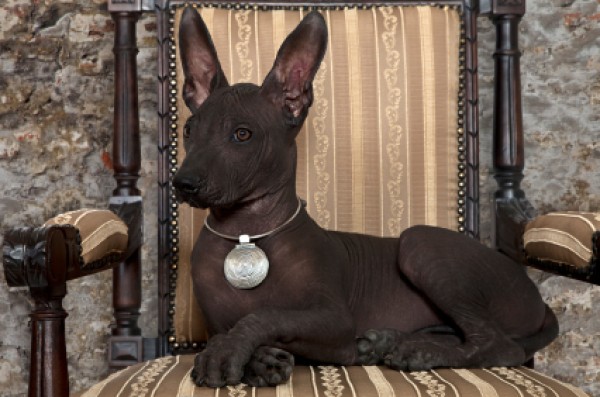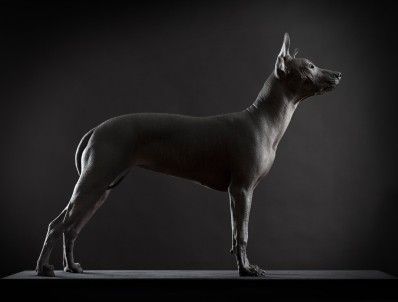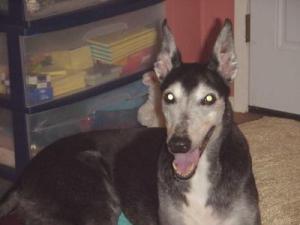
 Xoloitzcuintli (also known as the Mexican Hairless) is often called the unpronounceable breed of dog. Pronounced sho-low-eats-queent-li, this breed is known as much for being hairless (although there is a coated variety) as it is for its hard-to-pronounce name.
Xoloitzcuintli (also known as the Mexican Hairless) is often called the unpronounceable breed of dog. Pronounced sho-low-eats-queent-li, this breed is known as much for being hairless (although there is a coated variety) as it is for its hard-to-pronounce name.

The Xoloitzcuintli breed evolved in the jungles of Colima, Mexico. The name, Xoloitzcuintli, is from the ancient Mesoamerican god Xolotl, who was said to have created a protector and guide in the form of a hairless dog, to escort the souls of the dead to their eternal resting place. Thought of as guardians and protectors by many indigenous peoples, these highly valued dogs were sometimes sacrificed and buried with their owners to act as a guide to the soul on its journey to the underworld. Archeologists have discovered artifacts depicting Xolos in the tombs of Colima, Mayan, Toltec, Zapoteca, and Aztec Indians dating back over 3,500 years ago. To the Aztecs, they were considered a great delicacy and were occasionally raised and consumed for sacrificial ceremonies, including marriages and funerals.

In the modern world, Xolos were among the first breeds recognized by the American Kennel Club (AKC) and were added to the studbook under the name Mexican Hairless in 1887. In 1959, they were dropped from the AKC stud book due to the breed's scarcity and perceived extinction. In 1986, The Xoloitzcuintli Club of America was founded to regain AKC recognition for the breed. Xolos were finally readmitted to AKC studbook in December of 2010 and eligible to be shown in the AKC Non-Sporting group in 2011. They are the AKCs 170th breed and appeared at the Westminster Kennel Club Dog Show for the first time in 2012.
Xoloitzcuintli come in three sizes (standard, miniature, and toy) and two coat varieties (hairless and coated). Ranging in weight from 10 to 50 pounds, all sizes exhibit a lean and graceful outline and are described by the AKC as being strong, agile, and elegant.
The hairless gene is now the dominant trait in the Xoloitzcuintli breed and originated as a spontaneous mutation thousands of years ago. In a warm, tropical climate, less hair may have been an advantage. The recessive expression of the trait will produce the coated variety.
Hairless Xolos may have short coarse hair on the head, tail, and feet, while coated Xolos are covered in a short, sleek, tight-fitting coat. Unlike coated Xolos, hairless Xolos often have an incomplete set of teeth, along with primitive tusks that jut forward where their canines would normally be. This doesn't affect their appetites or interfere with their ability to eat, and is believed to be a result of the hairless gene.
Although somewhat sensitive to being touched, Xolo skin is actually a hide thick, protective, and resistant to injury. It exudes oils that help protect the dog against insects and the sun. The skin also darkens and tans with exposure to the sun. When young they may suffer from adolescent acne.
Coated varieties are covered by an attractive short, flat coat. In both varieties, a dark, uniform color is preferred, ranging from black, gray black, slate, to red, liver, or bronze, although white spots and markings are permitted.
All three sizes exhibit the typical temperament expected of a working breed somewhat reserved with strangers, but never timid or aggressive. Xolos are bred to be calm, tranquil, and aloof, yet attentive. They generally bond strongly with one owner, although they will connect with and love the entire family (including other pets). While friendly, they will not be as affectionate with strangers. In general, Xolos temperament makes them good guard dogs and excellent companions.
Adults Xolos usually have a calm temperament, but they can be extremely energetic, noisy, and chewy as puppies. They are a smart, high energy, and inquisitive breed and require a loving owner who can offer them consistent obedience and socialization training through puppyhood and beyond. Ideally, those considering a Xolo should have prior experience living and working with high-energy breeds.
Owners should expect to invest time and money into dog training for both themselves and their Xolo. This breed needs a safe environment and plenty of room for exercise. Because they possess strong social instincts, they are often happiest in households with more than one dog.
Xolos live an average lifespan of 14 to 17 years. The breed is quite hardy. They are not prone to many of the common health problems found in other purebred dogs. Having originated in the tropics, these dogs are not well suited to life in northern climates and even in warmer climates should only be thought of as indoor companions. Both the hairless and coated varieties are known for their cleanliness and can often be seen meticulously grooming themselves. In some cases, people who normally find themselves allergic to dogs find that they can live comfortably with both the hairless and coated varieties of the breed (this varies from person to person).
Xolos appear in paintings by famous Mexican artists such as Diego Rivera and Frida Kahlo.
Xolos are the official dog of Mexico and considered a national treasure by its people.
The Mexican Hairless breed is not well known in the United States. As a result, there have been several cases where individual animals have been mistaken for the mythical creature known as Chupacabra.
Xoloitzcuintli is the symbol of Club Tijuana, a Mexican professional football club.
Indigenous people believed Xolos could help heal certain conditions like rheumatism, asthma, toothache, and insomnia. The belief still survives today in the rural parts of Mexico. Because Xolo skin feels warm to the touch, they can act as a sort of hot water bottle when lying next to you.
Most Xoloitzcuintli litters contain both hairless and coated puppies.
Source: http://www.xoloworld.com, Xoloitzcuintli Club of America; The Xoloitzcuintli Club USA; American Kennel Club; Wikipedia "Mexican Hairless Dog".
Add your voice! Click below to comment. ThriftyFun is powered by your wisdom!
This dog looks a lot like a Greyhound with a slightly different body structure. Greyhounds were raised in Ancient Egypt and on the walls of the pyramids you will see many pictures of Anubis the Egyptian Dog of the Dead who protected & guided the people after they died. Just like the Xoloitzcuintli.
See picture of my Greyhound and yes-they too come in three different sizes and many colors.

A fine animal but I have to disagree that it 'evolved'. No such process has ever been shown by science to have ever taken place.
Add your voice! Click below to comment. ThriftyFun is powered by your wisdom!